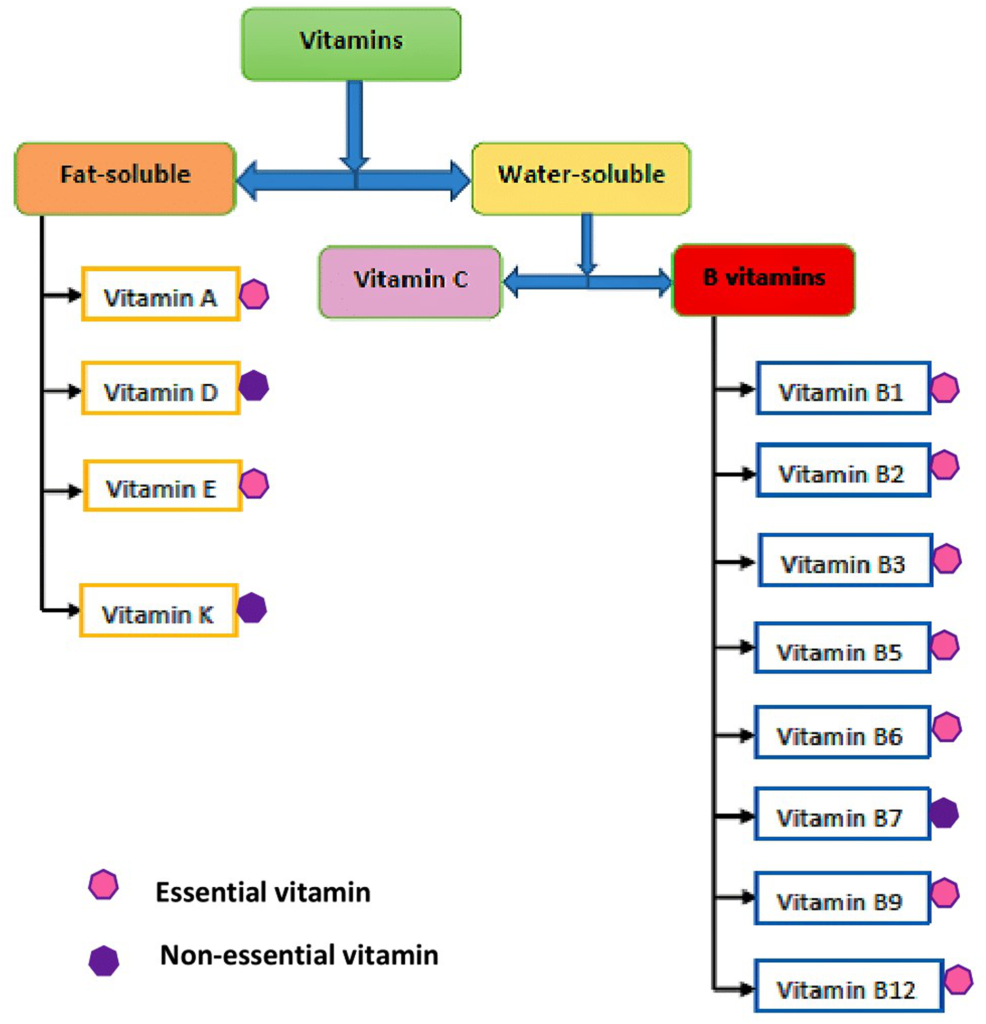Vitamins are essential organic compounds that our bodies need in small amounts to function properly. Unlike macronutrients such as carbohydrates, proteins, and fats, vitamins do not provide energy but are crucial for various biochemical processes that sustain life.
Classification of Vitamins
Vitamins are broadly classified into two categories based on their solubility:
- Fat-Soluble Vitamins:
- Vitamins A, D, E, and K fall into this category.
- Characteristics:
- Stored in the body’s fatty tissues and liver.
- Can accumulate to toxic levels if taken in excess.
- Absorption is dependent on the presence of dietary fat.
- Functions:
- Vitamin A: Essential for vision, immune function, and skin health.
- Vitamin D: Important for calcium absorption, bone health, and immune function.
- Vitamin E: Acts as an antioxidant, protecting cells from damage.
- Vitamin K: Necessary for blood clotting and bone health.
- Water-Soluble Vitamins:
- Vitamins B-complex and C fall into this category.
- Characteristics:
- Not stored in large amounts; excess is excreted in urine.
- Need to be consumed more regularly than fat-soluble vitamins.
- Functions:
- Vitamin C: Important for collagen synthesis, antioxidant protection, and immune function.
- Vitamin B-complex: A group of eight vitamins that play vital roles in energy production, red blood cell formation, and nervous system health. These include:
- B1 (Thiamine): Energy metabolism and nerve function.
- B2 (Riboflavin): Energy production and skin health.
- B3 (Niacin): Metabolism of carbohydrates, fats, and proteins.
- B5 (Pantothenic acid): Synthesis of coenzyme A, important in metabolism.
- B6 (Pyridoxine): Amino acid metabolism, neurotransmitter synthesis.
- B7 (Biotin): Metabolism of fatty acids and amino acids.
- B9 (Folate): DNA synthesis and repair, important in pregnancy.
- B12 (Cobalamin): Red blood cell formation, neurological function.
Sources of Vitamins
Vitamins must be obtained from the diet because the human body either cannot produce them at all or cannot produce them in sufficient quantities. Different foods provide different vitamins:
- Fruits and Vegetables: Rich in vitamins C, A, and K.
- Meat, Fish, and Dairy: Sources of B vitamins and vitamin D.
- Nuts and Seeds: Provide vitamin E.
- Fortified Foods: Some foods are fortified with vitamins, like vitamin D in milk or folic acid in cereals.
Functions of Vitamins
Vitamins are involved in a wide range of bodily functions:
- Metabolism: Many vitamins, especially B-complex, are cofactors or precursors for enzymes involved in metabolic pathways.
- Immunity: Vitamins like A, C, and D play key roles in maintaining and regulating the immune system.
- Growth and Development: Vitamins are essential for normal growth, development, and cellular repair.
- Antioxidant Protection: Vitamins C and E help protect cells from oxidative damage caused by free radicals.
Deficiency and Toxicity
- Deficiency: A lack of adequate vitamins in the diet can lead to deficiency diseases. For example:
- Vitamin D deficiency can cause rickets in children and osteomalacia in adults.
- Vitamin C deficiency leads to scurvy, characterized by bleeding gums and weakened immunity.
- Vitamin B12 deficiency can result in anemia and neurological issues.
- Toxicity: Excessive intake of certain vitamins, particularly fat-soluble ones like vitamins A and D, can lead to toxicity, causing adverse health effects.
Importance in Health
Vitamins are vital for maintaining overall health, supporting everything from the immune system to brain function. They are also important in preventing chronic diseases. For instance, vitamin D is linked to bone health, and antioxidants like vitamin C and E are associated with a reduced risk of chronic diseases like heart disease.

